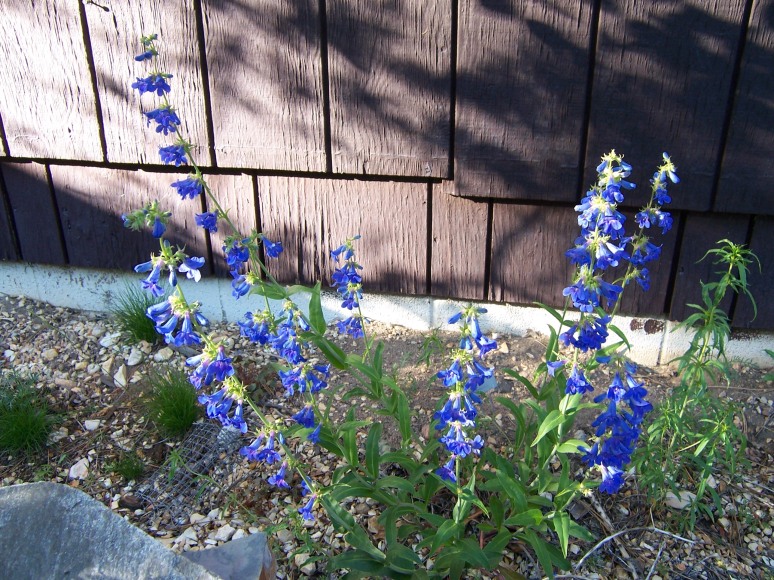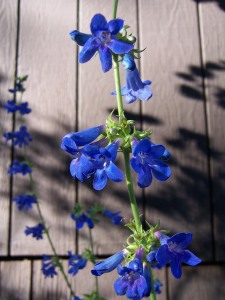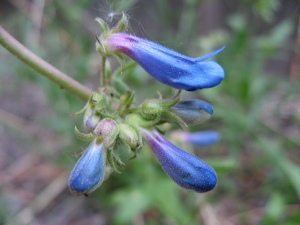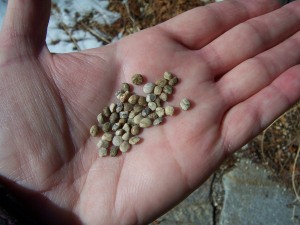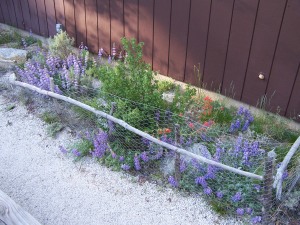Aquilegia formosa, Crimson Columbine
Crimson columbine is a colorful and delicate-looking woodland plant that does best in a cool, partially shaded location where the soil does not dry out during the growing season. It will do fine in full sun as long as there is sufficient moisture and no reflected heat. Hummingbirds and bumblebees love the nectar the flowers provide, and songbirds and chipmunks eat the shiny black seeds. This columbine is native to much of the western United States. It is fairly common here in Tahoe, and blooms from late spring to early summer. Its flower spikes can get up to three feet tall.
Aquilegia formosa hybridizes readily with other varieties of columbine and will seed around the garden. Keep this plant isolated unless you want hybrids. In the central and southern Sierra Nevada, Crimson columbine hybridizes with another Sierra native, the white-flowered Aquilegia pubescens. The hybrids can have spectacular flowers in shades of pink, white, and yellow. Aquilegia pubescens does not occur as far north as the Tahoe basin.

Crimson columbine in the garden with a silver-spotted form of Siberian bugloss, yellow Johnny jump-ups, and shrubby Dart's Gold ninebark in the background on the upper left.
Crimson columbine is easy to grow from seed, either in pots or by sowing the seed directly in the ground in the fall. For pot culture, a standard potting soil works well. I use four-inch pots and plant about six to nine seeds per container about a quarter of an inch below the surface. A thin layer of pumice over the soil helps protect the seeds from drying out during germination, and helps protect the soil surface from hard rain. I prick the seedlings out and pot them up in their own small containers when they have developed several sets of leaves. The plants start blooming in their second year. I have had success starting seeds in pots as late as April. According to Dara Emery’s Seed Propagation of Native California Plants, Aquilegia formosa does not need a cold period to germinate. This species makes a good container plant.
This columbine combines beautifully with other native plants that prefer partially shaded, moist conditions like Sticky cinquefoil (Potentilla glandulosa), Fan-leaf cinquefoil (Potentilla flabellifolia), Meadow penstemon (Penstemon rydbergii), Jacob’s ladder (Polemonium occidentale), Coulter’s daisy (Erigeron coulterii), Fendler’s meadow rue (Thalictrum fendleri), Velvety stickseed (Hackelia velutina), and Bigelow’s sneezeweed (Helenium bigelovii). Crimson columbine looks great planted under aspen trees and amongst native grasses. I love sitting out in the garden and watching the hummingbirds go nuts over this plant!
Penstemon speciosus, Showy Penstemon
This Sierra native penstemon is a wonderful plant for the dry garden. The flower color is highly variable and can range from a light sky blue to dark purple. This penstemon blooms from late spring into early summer and easily tolerates lean soil and drought. It needs at least four hours of direct sun daily. The forms I have in the garden are relatively low growing, and range anywhere from three to ten inches tall. In the wild, I’ve seen plants that are as large as two feet tall. Generally, the higher the elevation, the lower growing the plant. Check out the Calphotos website for more photos of showy penstemon: http://calphotos.berkeley.edu/cgi/img_query?where-genre=Plant&where-taxon=Penstemon+speciosus
Showy penstemon combines well with other drought-tolerant, sun-loving native plants like Firecracker flower (Ipomopsis aggregata), Wooly sunflower (Eriophyllum lanatum var. integrifolium), Woolly mules ears (Wyethia mollis), Nuttall’s linanthus (Linanthus nuttallii), and Sulphur buckwheat (Eriogonum umbellatum). I’ve seen bees pollinating the flowers. So far I have never noticed hummingbirds visiting this plant, but perhaps it’s because the flower spikes of the plants in my garden tend to grow almost horizontally to the ground. This penstemon does not need any supplemental watering, but during very dry summers, when we get no thunderstorms, I will give them one watering while they are in bloom to extend the flowering period slightly.
Penstemon speciosus is fairly easy to start from seed in pots. Cactus mix or standard potting soil (no manure) mixed with some perlite or pumice works well. I sow the seed in the fall about a quarter of an inch under the soil, then top up the pot with another quarter inch of pumice. If you direct sow the seed, do so in the fall as well. Like most natives, the seeds of this species need a cold period to germinate. Cuttings of this plant root fairly readily in perlite. Dip the ends of the cuttings in rooting hormone before placing in the perlite. Most plants begin blooming in their second or third year.
All in all, a lovely, carefree native plant. The photos below were taken near Monument Pass and the Tahoe Rim Trail in South Lake Tahoe. Check out those turquoise flowers!
Penstemon mensarum, Grand Mesa Beardtongue
Some of the bluest flowers I’ve ever seen belong to Penstemon mensarum. This penstemon is native to western Colorado, specifically Mesa, Delta, and Gunnison Counties, and is easy to grow in the Tahoe garden. This penstemon is a bit unusual in that it can tolerate fairly regular watering. In my garden, it gets a good soaking every one to two weeks. It will survive on much less, but look wilted and unhappy in hot weather. I grow this species in a sunny area next to some Aspen trees. I also have a plant growing against a southwest facing wall of the house.
Penstemon mensarum gets up to 2 feet tall and 18 inches wide, and is tolerant of hot sun, extreme cold, wind and violent hailstorms. It should get at least three to four hours of direct sunlight a day, otherwise the flower spikes get elongated and droopy. There are lots of gophers and voles in my yard. This penstemon does not seem to be one of their favorite snacks, which is nice! Over the years they have eaten only one plant. Penstemon mensarum combines beautifully with bright-red Firecracker Flower (Ipomopsis aggregata). They both like similar conditions and bloom at the same time. This plant is pollinated by bees and hummingbirds.
I originally purchased seed from the now-defunct Rocky Mountain Rare Plants. This company was a wonderful resource for all sorts of unusual and beautiful alpine plant seeds. Though I haven’t bought anything from them yet, Western Native Seed looks like a good place to purchase penstemon and other western native seeds: http://www.westernnativeseed.com/wildflowers.html As of this writing (April 2012) High Country Gardens sells Penstemon mensarum plants: http://www.highcountrygardens.com/index/page/product/product_id/3660
For anyone interested in growing penstemons in the garden, I’d highly recommend the book, Penstemons, by Robert Nold, an author from Lakewood, Colorado. Northwest Penstemons by Dee Strickler is also a wonderful book, and is loaded with color photographs.
Ipomopsis aggregata, Firecracker Flower
If you love hummingbirds, plant some of these! This drought tolerant native is long blooming and easy to grow. Firecracker flower is generally a biennial. The first year it forms a rosette of leaves. During its second year of life it creates spectacular tubular flowers in varying shades of red, then dies in the fall. In very poor soil or harsh conditions, it can take three or more years to bloom. A few plants in my yard have been short lived perennials. They have formed flower spikes in the second year of growth, bloomed, and died down once the hard frosts hit. The following year multiple flower spikes appeared from what I thought was a dead plant. One plant has been alive for four years. Firecracker flower can start blooming in early June in a drier year with a warm spring. With a small amount of supplementary watering (one good soaking a month in July and August) it can bloom until the fall.
Firecracker flower seeds around in the garden and is quite adaptable. In the wild it tends to grow in dry soil that only receives water from snow melt and summer rain showers. In the garden, it will tolerate watering once a week. I tend to water the main part of my garden in the late afternoon, once the yard is out of hot sunlight. Firecracker flowers respond well to this “afternoon thunderstorm”, growing larger and blooming for a longer period of time.
This plant can grow anywhere from eight to thirty inches tall, depending on the conditions. The happiest looking and longest blooming plants grow in sunny areas that get some shade in the afternoon, during the hottest part of the day. Direct sow the seed in the fall.
Firecracker flower is not only a great nectar plant for hummingbirds, it also attracts swallowtail butterflies. Chipmunks gather the seeds and stuff them in their cheek pouches once they are ripe.
This plant has hybridized in my garden with the white flowered and fragrant Ipomopsis candida, a native of Colorado and New Mexico. The hybrids are a pale orange-white to a creamy red-orange and also tend to be fragrant. Sphinx moths love the hybrids as well as the pure white flowers of Ipomopsis candida.
Lupinus grayi
Also known as Gray’s Lupine, this is a common, low-growing lupine that can carpet the forest floor with color in the late-spring and early summer. The flowers are most often a rich purple-blue color, but also come in shades of pink and white. There is a lovely plant that grows just above my house here in Tahoe that has light pink flowers with a raspberry-colored splotch on the banner petal. (Shown at the bottom of this post) In my yard, Lupinus grayi ranges from about seven inches to sixteen inches tall when in bloom, with a spread of up to two feet. Some plants can be quite fragrant. This lupine does well in hot, dry areas in full sun, and in partially shaded locations. I’ve observed bumblebees pollinating the flowers. Chipmunks and Douglas Squirrels like to eat the unripe seeds. Lupines are in the pea family, but the seeds are poisonous to humans.
In the dry garden, Lupinus grayi is easy to grow, flowering in its second year. Some plants take longer to bloom in severely depleted soil. However, being nitrogen-fixers, lupine species do well in soil with few nutrients. Several years ago my husband and a friend removed part of our driveway. This lupine species was the first thing I planted in the compacted, sterile-looking soil that was underneath the asphalt. The plants seemed unfazed by the poor soil. This is a species to consider when confronted with a totally bare yard where previous residents have spent years meticulously removing pine needles and other organic matter from the soil surface. Lupinus grayi is good for revegetating bare roadcuts, and other hot and sunny or partially shaded slopes. It seeds around quite prolifically. This is not a plant for the regularly watered garden.
Each individual plant produces seeds with unique patterns on the seed coat. It’s fun to look at each pattern carefully. A good place to find seeds is on the street near large patches of this species. Depending on the weather, the seeds ripen in mid-July to early-August. You’ll know you have timed your seed gathering right if you can hear the faint snapping sound of the ripe seed pods ejecting their seeds. Since they resemble small pieces of decomposed granite, the seeds can be hard to see on the asphalt. Make sure to watch out for traffic, and be prepared for curious looks from the neighbors! When gathering seed pods directly from plants, you’ll know if the pods are ripe if they are dry, light-beige in color, and crack when bent. The dry seedpods can break apart easily and eject their seed when picked, so clasp your hand around them carefully. Don’t gather green seed pods, or drier-looking pods that are still flexible. The immature seeds will not germinate. I’m in the habit of always planting a portion of the seeds I gather near the plants I took them from.
Direct sow the seeds about a half-inch deep in the fall or even winter, if there is little snow. I often wait to plant seeds until the chipmunks go into hibernation in mid-fall, otherwise, there is a chance they could dig the seeds up after they have been planted. Spring planting (March or April) can work if the seeds are scarified and briefly soaked in warm water. To scarify a seed, carefully chip off a tiny portion of the seed coat with the edge of a knife. Put the scarified seeds in a bowl and pour warm water over them. The seeds will absorb water and swell up significantly. It can take a few minutes to several hours for the seeds to absorb water. Try to plant the seeds immediately after they swell up. Germination usually occurs a few weeks after the snow melts off the soil.
I have not had success planting lupine species any later than April. The young seedlings seem to be able to tolerate cool, moist soil but tend to rot if they are going through germination during those warm May days when the soil is still saturated.
Lupinus grayi blooms around the same time as many other colorful, dry-growing native plants like Phlox diffusa, Buckwheat species such as Eriogonum umbellatum and Eriogonum ursinum, Linanthus nuttallii, Calochortus leichtlinii, Penstemon speciosus, Wyethia mollis, Ipomopsis aggregata, and Calyptridium umbellatum.
Hello!
The primary purpose of this blog is to share what I’ve learned about the native plants of California’s Sierra Nevada. I’ve been gardening with these plants here in Tahoe for almost sixteen years now. I’m hoping to encourage people to get started with their own native plant gardens. Many of these plants do well in containers, so you don’t need a yard. For people who aren’t into gardening, I’m hoping this blog might persuade some readers to bring a native wildflower book on their next hike. I have found knowing about the local plants makes for a much richer wilderness experience.
I enjoy gardening with native plants not only because of their beauty, but because these plants provide food and shelter for local wildlife. In this time of widespread environmental degradation and habitat loss, I feel the need to give back; to lessen my impact on the environment in a concrete way.
While I love native plants, I don’t garden with them exclusively. There are plenty of non-natives that do wonderfully in the Sierra Nevada mountains. I’ll be writing about them too.
I also love to hike and go on backpacking trips, so I’ll be posting trip reports with plenty of photos of wildflowers in their native habitats.
Cheers!
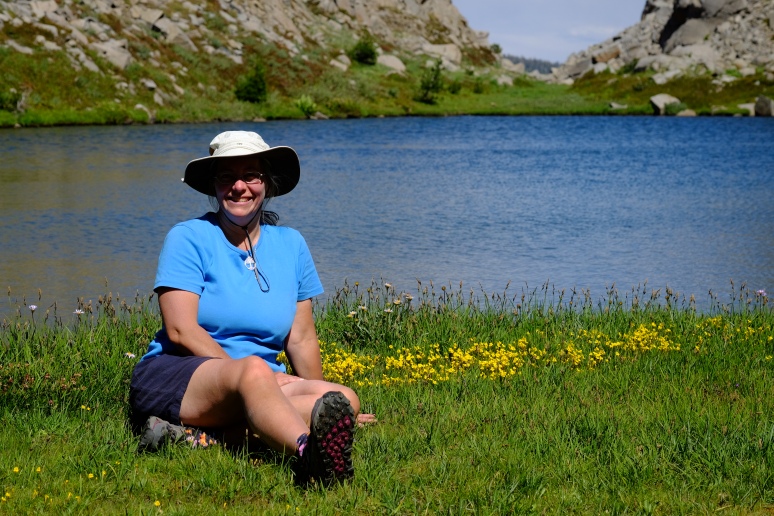
Near Fourth of July Lake.
-
Recent Posts
Archives
Native Plants in the Garden
Meta






